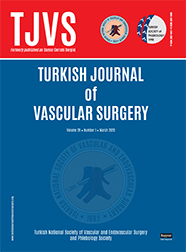
The Turkish Journal of Vascular Surgery
Yazarlar: Deniz Sarp Beyazpınar, Ali Harman, Nükhet Akovalı, Özgür Ersoy, Çağrı Kayıpmaz, Bahadır Gültekin, Hakkı Tankut Akay
Konular:-
Anahtar Kelimeler:Carotid artery endarterectomy; carotid artery eversion; carotid artery patch plasty; carotid artery restenosis; carotid artery stenting
Özet: Objectives: In this study, we aimed to present our treatment modalities for carotid artery stenosis and approaches for post-treatment restenosis. Patients and methods: Between January 2003 and June 2017, 557 patients (304 males, 253 females; mean age 68.2 years; range, 54 to 82 years) who underwent an intervention due to carotid artery stenosis were retrospectively analyzed. A total of 392 patients underwent carotid artery endarterectomy (CAE), while 165 patients underwent carotid artery stenting (CAS). Of 392 patients, 34 (8.6%) underwent eversion, 188 (47.25) underwent patch closure, and 170 (43.3%) underwent primary closure. Of 165 patients undergoing CAS, 114 (69%) had a wallstent and 51 (31%) had a nitinol stent. Carotid artery restenosis (CAR) and risk of treatment modalities were evaluated in both groups. Results: A total of 29 patients (5.2%) had CAR. Of these patients, eight (4.84%) were from the CAS group, while 21 (5.35%) were from the CEA group. Of the patients undergoing primary closure, the rate of need for reintervention was 9.4% (n=16), this rate was 5.88% (n=2) in the patients undergoing eversion. In the patient group undergoing patch closure, the rate of need for reintervention was 1.59% (n=3). Twenty six patients with CAR underwent endovascular intervention, while two patients underwent surgical intervention. No mortality was observed in patients undergoing surgical intervention. Only nerve damage was seen in both patients. No mortality was observed in patients undergoing endovascular intervention due to CAR; however, one patient had major stroke. Conclusion: Gold standard treatment method in carotid artery stenosis is CAE. Endovascular treatment modalities can be a good alternative to CAE in patients with high comorbidity and high mortality risks and in case of CAR.